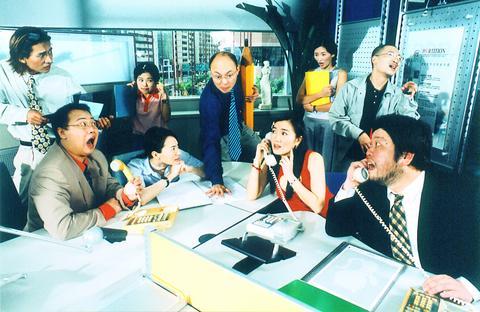Outdoor performances aren't anything new in Taiwan, but Green Ray Theater's latest venture, which is to be presented in the plaza of the National Theater on the night of the mid-Autumn festival, is something of a first. It is the only time that a complete production of a stage musical has been performed on an outdoor stage.
The performance is going to be somewhat experimental on the technical front, although the show, Necktie and High Heels -- which premiered back in 1994 has been staged numerous times around the island and even in the US since then -- is about as mainstream as a musical can get.

PHOTO COURTESY OF GREEN RAY THEATER
While members of the audience will be getting a dose of the well-loved songs, in many cases sung by original cast
members, for the first time it will be in the less structured environment of an outdoor arena.
Moreover, as no admission will be charged, the cast and crew are all slightly nervous about performing before an audience that is not firmly and respectfully seated in an auditorium.
Another potential problem is the use of large format video screens to bring the show to an even greater audience.
"We must find a balance between stage presentation and movie presentation," said Luo Pei-an (羅北安), the director of the show. "If the gestures are too subtle, the stage audience won't me able to see them, and if they are too exaggerated, it will look silly on the screen."
The challenges of the outdoors will also exercise the minds of the organizers, the CKS Cultural Center.
"In the past, we have always favored musical works, because there are fewer technical issues," said a spokesperson for CKS Cultural Center. "This is the first time we have worked with something with so much dramatic content."
For most Taiwan theatergoers, the story of Necktie and High Heels doesn't need any introduction, and even for those who have not yet caught this show sometime during the last 10 years, suffice to say that it is about the lives and loves of a bunch of Taipei office workers. With a string of sell-out performances behind it, this should prove a good way of getting into evening spirit of mid-autumn.

Nov. 11 to Nov. 17 People may call Taipei a “living hell for pedestrians,” but back in the 1960s and 1970s, citizens were even discouraged from crossing major roads on foot. And there weren’t crosswalks or pedestrian signals at busy intersections. A 1978 editorial in the China Times (中國時報) reflected the government’s car-centric attitude: “Pedestrians too often risk their lives to compete with vehicles over road use instead of using an overpass. If they get hit by a car, who can they blame?” Taipei’s car traffic was growing exponentially during the 1960s, and along with it the frequency of accidents. The policy

Hourglass-shaped sex toys casually glide along a conveyor belt through an airy new store in Tokyo, the latest attempt by Japanese manufacturer Tenga to sell adult products without the shame that is often attached. At first glance it’s not even obvious that the sleek, colorful products on display are Japan’s favorite sex toys for men, but the store has drawn a stream of couples and tourists since opening this year. “Its openness surprised me,” said customer Masafumi Kawasaki, 45, “and made me a bit embarrassed that I’d had a ‘naughty’ image” of the company. I might have thought this was some kind

What first caught my eye when I entered the 921 Earthquake Museum was a yellow band running at an angle across the floor toward a pile of exposed soil. This marks the line where, in the early morning hours of Sept. 21, 1999, a massive magnitude 7.3 earthquake raised the earth over two meters along one side of the Chelungpu Fault (車籠埔斷層). The museum’s first gallery, named after this fault, takes visitors on a journey along its length, from the spot right in front of them, where the uplift is visible in the exposed soil, all the way to the farthest

The room glows vibrant pink, the floor flooded with hundreds of tiny pink marbles. As I approach the two chairs and a plush baroque sofa of matching fuchsia, what at first appears to be a scene of domestic bliss reveals itself to be anything but as gnarled metal nails and sharp spikes protrude from the cushions. An eerie cutout of a woman recoils into the armrest. This mixed-media installation captures generations of female anguish in Yun Suknam’s native South Korea, reflecting her observations and lived experience of the subjugated and serviceable housewife. The marbles are the mother’s sweat and tears,